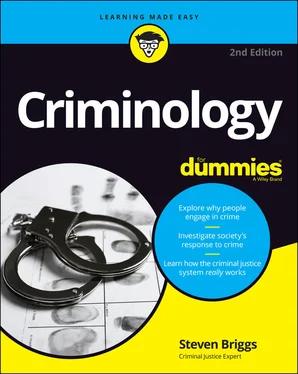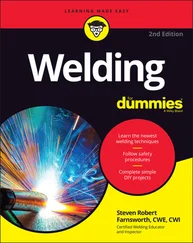 Tallying some of the costs
Tallying some of the costs
 Categorizing crime
Categorizing crime
 Trying to explain why people commit crime
Trying to explain why people commit crime
 Fighting, prosecuting, and punishing crime
Fighting, prosecuting, and punishing crime
Entering the world of crime — and I mean really entering it — seriously affects a person. Working in a world of violence and deceit is a hard and trying business. Nonetheless, criminologists and criminal justice professionals devote their lives to studying crime and criminals with the ultimate goal of keeping people safe. In this chapter, you get a brief overview of the criminal world — from what causes crime to what society can do about it.
Defining the Terms: What Crime Is and How You Measure It
Technically, a crime is what your legislature says it is. If legislators want to outlaw riding a horse over 10 mph, they can. (It’s against the law to do so in Indianapolis, for example.)
 But just outlawing an activity doesn’t make it a crime. For example, running a red light is illegal, but it isn’t a crime (you only pay a fine). A crime is something you can get locked up for.
But just outlawing an activity doesn’t make it a crime. For example, running a red light is illegal, but it isn’t a crime (you only pay a fine). A crime is something you can get locked up for.
Taking away a person’s liberty is what separates illegal criminal conduct from illegal conduct that is not criminal. And when the possibility of going to jail is involved, you have a number of constitutional rights that don’t apply when you’re caught for a traffic violation, including the following:
The right to an attorney
The right to a jury, which can convict you only if the evidence is beyond a reasonable doubt
The right to remain silent and not have your silence used against you
Identifying elements of criminal behavior
Crime isn’t as simple as it seems at first blush. If I signed my credit card receipt in a store and accidentally walked away with the pen, did I commit theft? Of course not. I didn’t intend to steal the pen. To be guilty of a crime, I must have some mental culpability, such as criminal intent. Taking a pen is a crime only if a prosecutor can prove that I intended to deprive the owner of his pen.
In addition, committing a crime requires a physical act. It’s not illegal just to think about committing a crime; you must physically do something. (Of course, a few exceptions exist. For example, not paying your taxes can constitute a crime.) I explore the elements of a criminal law (which is a law that defines a crime) in greater detail in Chapter 2.
Not all crimes are equal. The law breaks down crimes into two categories, according to seriousness:
Misdemeanor: This type of crime includes the least serious offenses. Historically, misdemeanor crimes were crimes that couldn’t be punished by more than a year in jail. Today, however, because overcrowding in some jails is a serious problem, people convicted of misdemeanors, especially first-time offenders, may not get much jail time at all.
Felony: This type of crime is usually more serious and is punishable by more than a year in custody. Serious violent crimes like murder, rape, kidnapping, and robbery are felonies that can result in lengthy prison sentences.
Gathering crime statistics
You may think that determining the amount of crime in a given city, state, or country is a pretty simple task. But, in reality, it’s very challenging. For example, how do you gather statistics about illegal drug sales? Neither the seller nor the buyer is going to report a heroin deal. And wives who are beaten by their husbands don’t usually call the cops. In fact, only 41 percent of violent crimes were reported to the police in 2019.
The Federal Bureau of Investigation (FBI) has developed a system called the Uniform Crime Report for gathering basic statistics about nine serious felonies, known in the crime business as Part 1 crimes. Whenever one of the roughly 18,000 police agencies in the United States gets a report that one of these crimes has been committed, that agency passes the information on to the FBI. If the agency ends up making an arrest, it passes that information on, as well. The FBI incorporates this information in its annual crime report.
Recognizing the limits of crime reports and arrest statistics in measuring crime, the federal government created the National Crime Victimization Survey, which canvasses 95,000 households every year to ask whether members of those households have been victimized by crime. The idea is that this survey can gather information about crimes that aren’t reported to the police. This survey paints a pretty good picture of national crime trends, but the sampling just isn’t large enough to allow for an accurate assessment of crime trends at the state or local level. In Chapter 3, I get into the crime statistics business in much greater detail.
Recognizing the Various Costs of Crime
While criminologists try to gather accurate statistics about the amount of crime, economists focus on the financial costs of crime. And, of course, no one can forget the life-changing impact crime has on victims.
Noting the financial impact
The most obvious cost of crime to society is the money it takes to run the criminal justice system, including the following big-ticket items:
Police
Jails, prisons, and the staff to run them
Prosecutors
Judges and court staff
Defense attorneys to represent charged defendants at trial and on appeal
Probation officers
Juvenile justice counselors
Plus, in the United States, each of the three levels of government — local, state, and federal — may run its own justice system, which may include some or all of the preceding expenses.
In addition to governmental costs, society bears many other financial impacts of crime. For example, think of the lost productivity and lost tax revenue that occurs when a person decides to sell drugs rather than earn wages lawfully. Or think of the costs of providing medical care to victims of violence or the costs of developing cybersecurity for a corporation to protect its computer systems. The financial impact of crime is quite startling when you dive into it. In Chapter 3, I provide more details on the true cost of crime to all of society.
Respecting the price a victim pays
Crime doesn’t just carry an economic cost, however. Every day, thousands of lives are turned upside down by criminal violence and theft. Think of the impact on a senior citizen who’s defrauded out of her life savings or on a battered spouse who’s isolated from her friends and family and lives in constant fear of upsetting her husband. There’s simply no way to quantify the human toll of crime.
In the old days, crime victims were pretty much left to fend for themselves. But in the early 1980s, a movement began that brought help to victims. Today, in every state, a victim of violent crime can get financial help with medical bills, grief counseling, lost wages, and other economic losses. Victims can also get help understanding the criminal justice system.
Читать дальше

 Tallying some of the costs
Tallying some of the costs But just outlawing an activity doesn’t make it a crime. For example, running a red light is illegal, but it isn’t a crime (you only pay a fine). A crime is something you can get locked up for.
But just outlawing an activity doesn’t make it a crime. For example, running a red light is illegal, but it isn’t a crime (you only pay a fine). A crime is something you can get locked up for.










